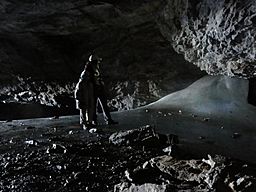Grotte Casteret facts for kids
The Grotte Casteret is a super cool ice cave found high up in the Spanish Pyrenees mountains. It's also called Gruta de Casteret or Gruta Helada de Casteret in Spanish. This amazing cave is inside the Ordesa y Monte Perdido National Park. A famous explorer named Norbert Casteret discovered it in 1926. The Grotte Casteret is famous for its huge room called the Grande Salle, which has a frozen lake. This lake is about 2,000 square metres (22,000 sq ft) big! The cave also has incredible ice shapes and a 20 metres (66 ft) tall ice wall leading to another part of the cave.
Contents
Exploring the Cave
The Grotte Casteret is located near the Brèche de Roland. It has a very impressive entrance that is about 50 metres (160 ft) wide and 15 metres (49 ft) high. After walking about 60 metres (200 ft) inside, you enter the huge Grande Salle.
The Grande Salle
The Grande Salle is a massive room with a floor made of clear ice. It's about 70 metres (230 ft) long, 60 metres (200 ft) wide, and 4 metres (13 ft) high. The ice floor is actually a frozen lake, covering about 2,000 square metres (22,000 sq ft). At one end of this chamber, you'll see giant ice columns.
Beyond the Main Hall
To the left of the Grande Salle, there's an opening that leads to another room called the Salle Maude. This room has a 20 metres (66 ft) tall ice wall, which is nicknamed Niagara. After the Grande Salle, the ice floor changes to a rocky path. This path goes for about 120 metres (390 ft) and then you have to climb up 3 metres (9.8 ft). This climb leads you to the surface, into a rocky area called a lapiaz field.
Other Entrances
There is a third entrance to the cave called the Puits Florence. It's a 60 metres (200 ft) deep hole on the plateau above the cave. The last 50 metres (160 ft) of it is a straight drop down into the Grande Salle.
History of Discovery
The Grotte Casteret was first explored by the Casteret family in July 1926. This included Norbert Casteret, his mother, his wife, and his brother. They explored most of the main passage. Norbert and his wife came back in September 1926 and managed to travel all the way through the cave.
Later Discoveries
The Salle Maude was found and explored in August 1950 by Norbert Casteret and his daughters, Maude and Gilberte. The third entrance, the Puits Florence, was first explored by a group called the Club Martel in August 1975.
How the Cave Formed
The Grotte Casteret formed in Cretaceous limestone. The ice in the Grande Salle formed because cold air flows through the cave system. Areas where the air doesn't move as much turn into water. Scientists believe the deeper ice in the cave is very old. It might even be left over from a very cold period long ago called the Quaternary period.
Changes in the Ice
The amount of ice in the Grande Salle has actually gotten smaller since the cave was discovered. For example, in 1950, the entrance to the Salle Maude was a very low crawl over the ice, only about 30 centimetres (12 in) high. But by 1988, the gap was 150 centimetres (4.9 ft) high because the ice floor had melted lower.
Visiting the Cave
The Ordesa y Monte Perdido National Park authorities control who can enter the Grotte Casteret. There's a barrier at the entrance, and a sign tells regular visitors not to go in. Only special groups of up to 6 cavers are allowed to visit, for a maximum of four days each month. This helps protect the cave and its delicate ice formations.
See also
 In Spanish: Gruta de Casteret para niños
In Spanish: Gruta de Casteret para niños


